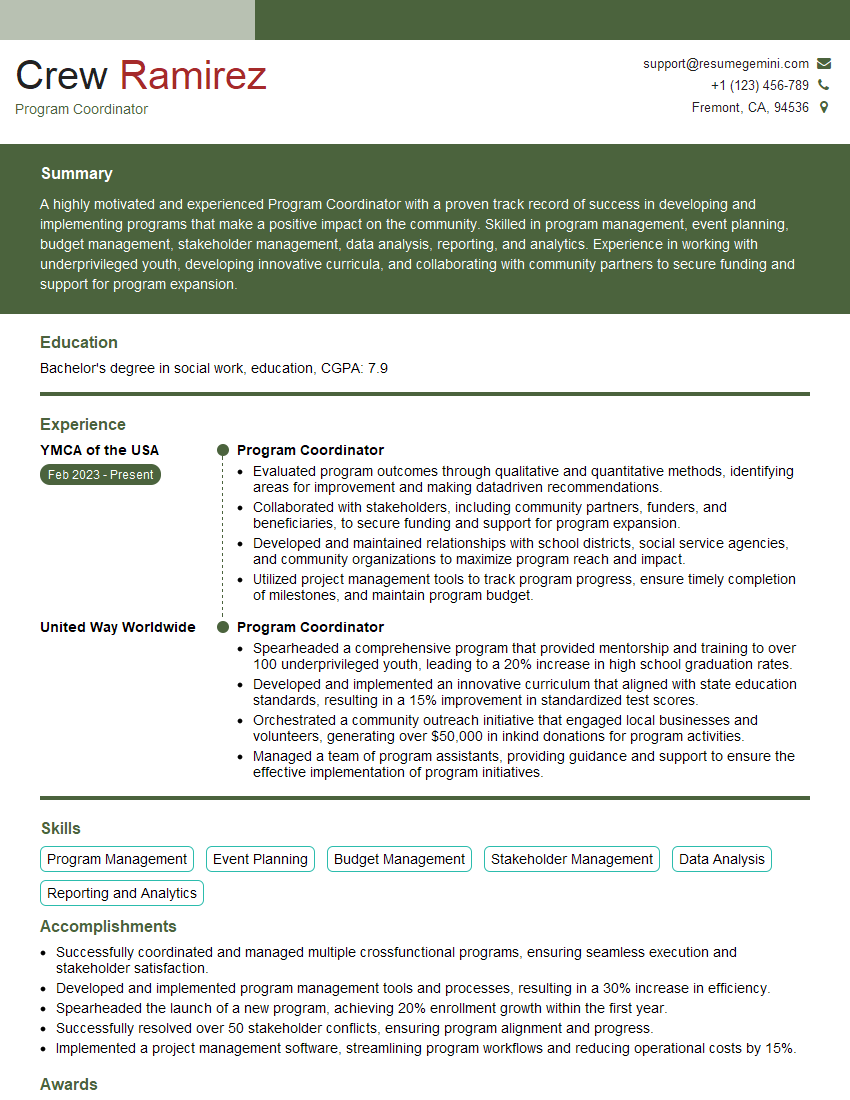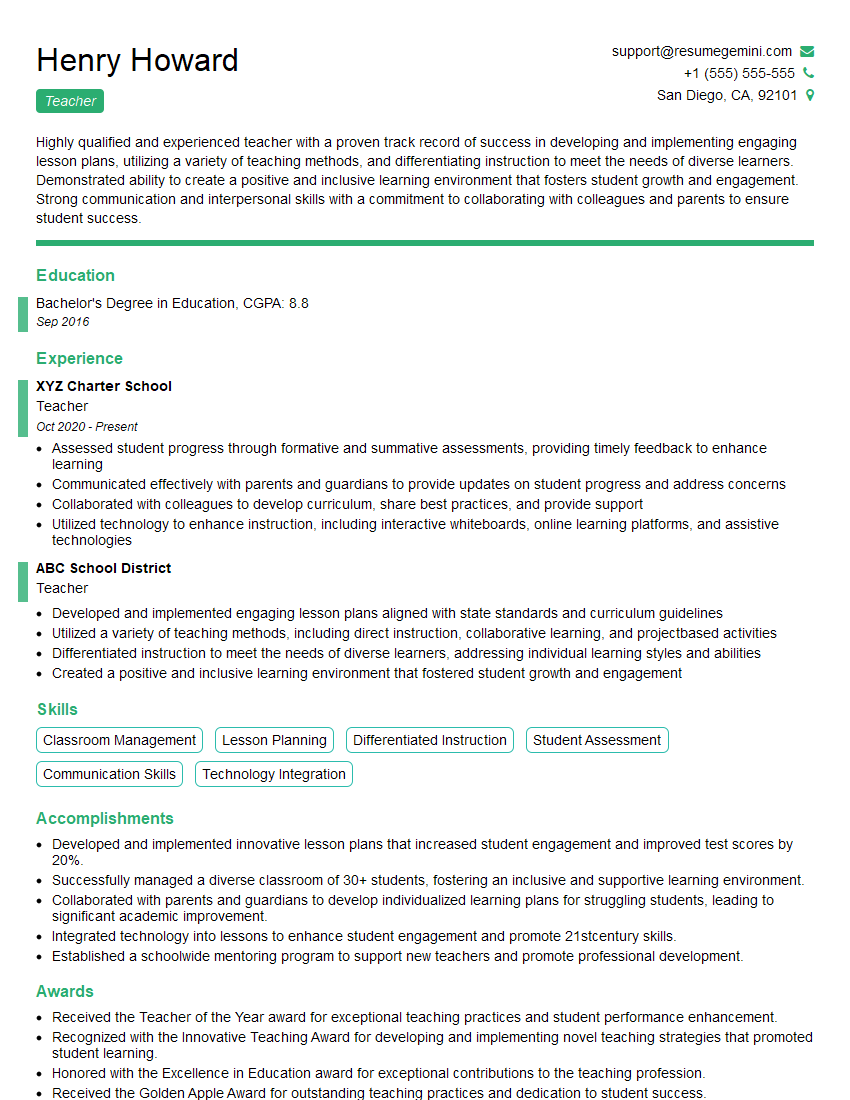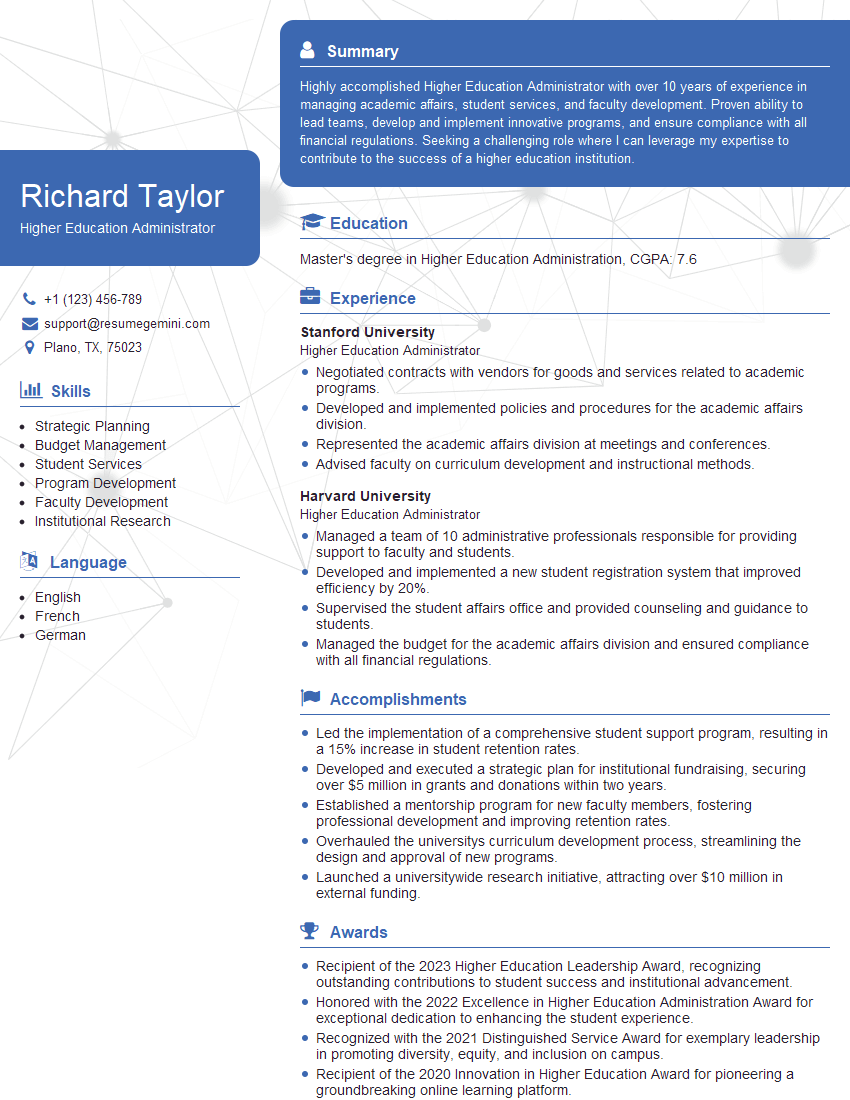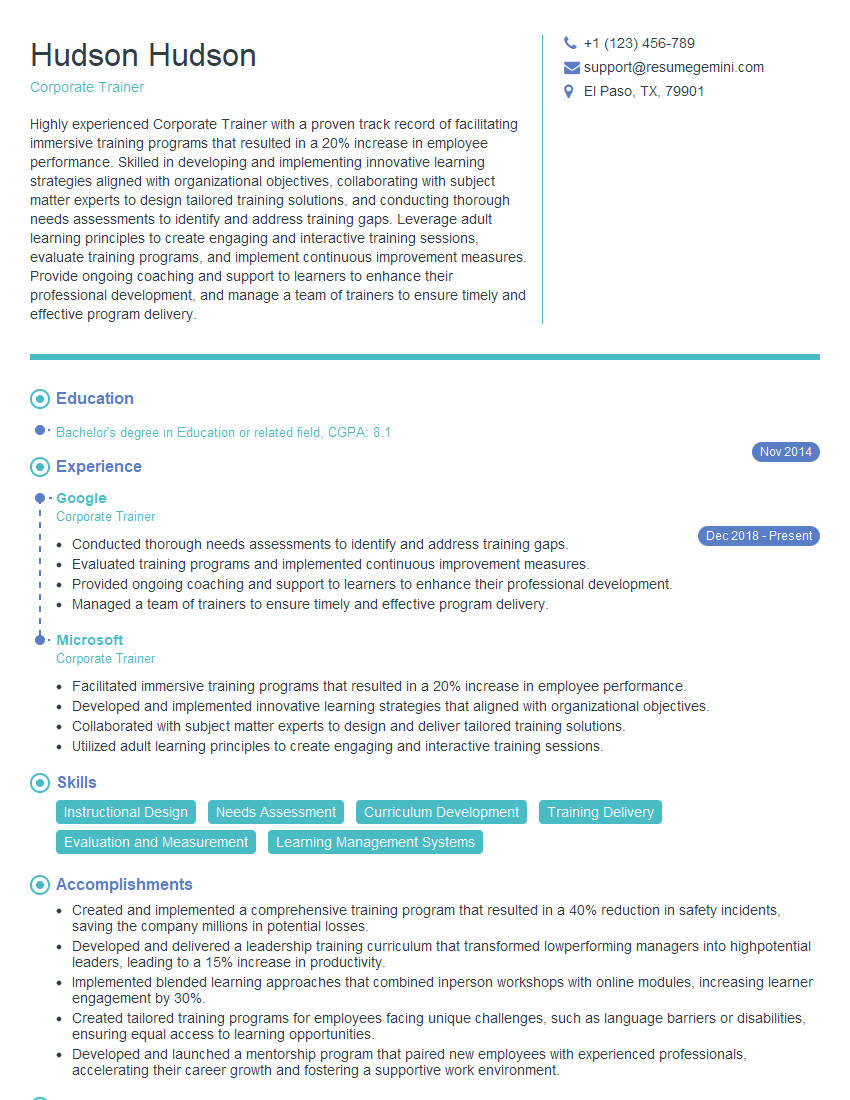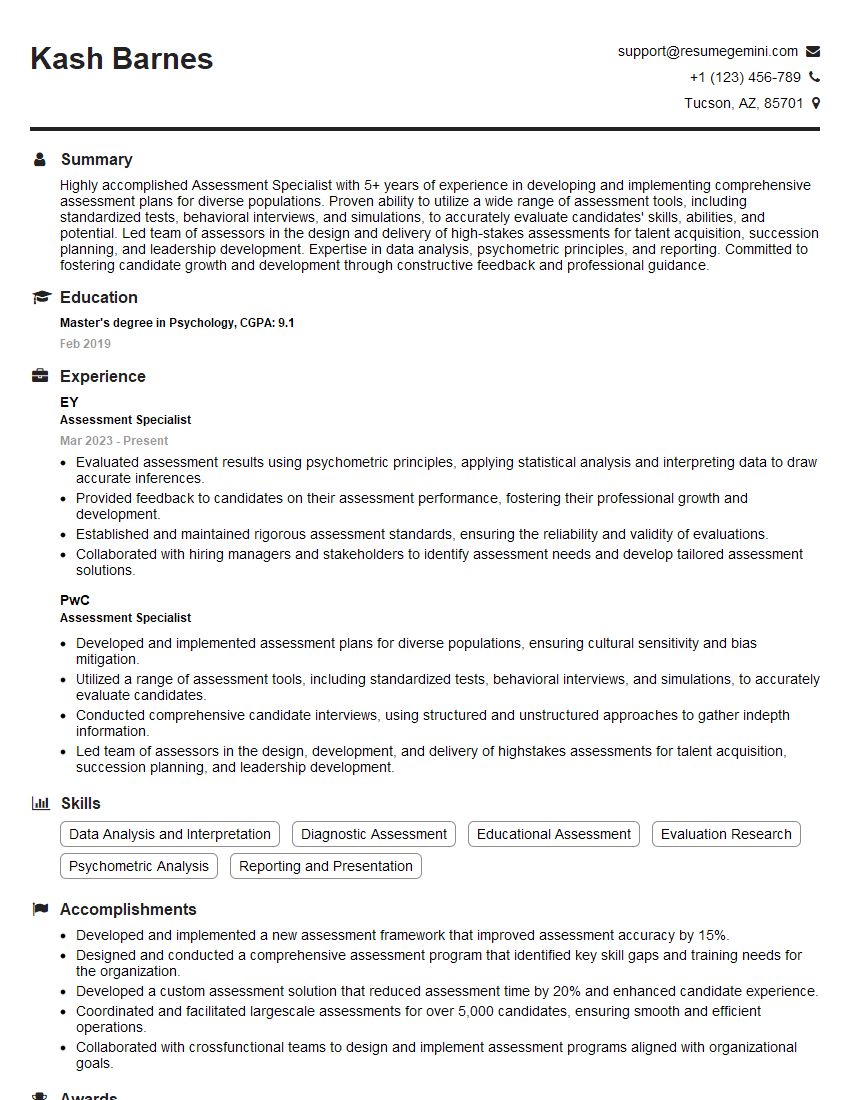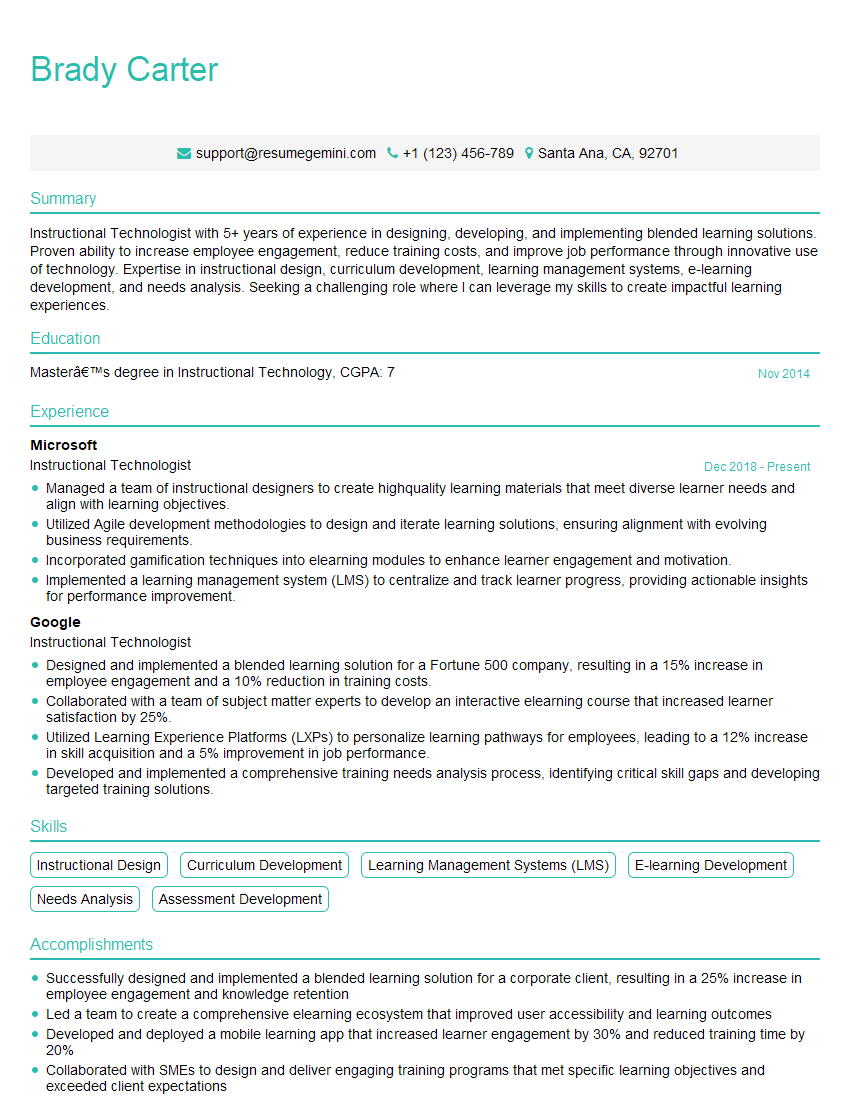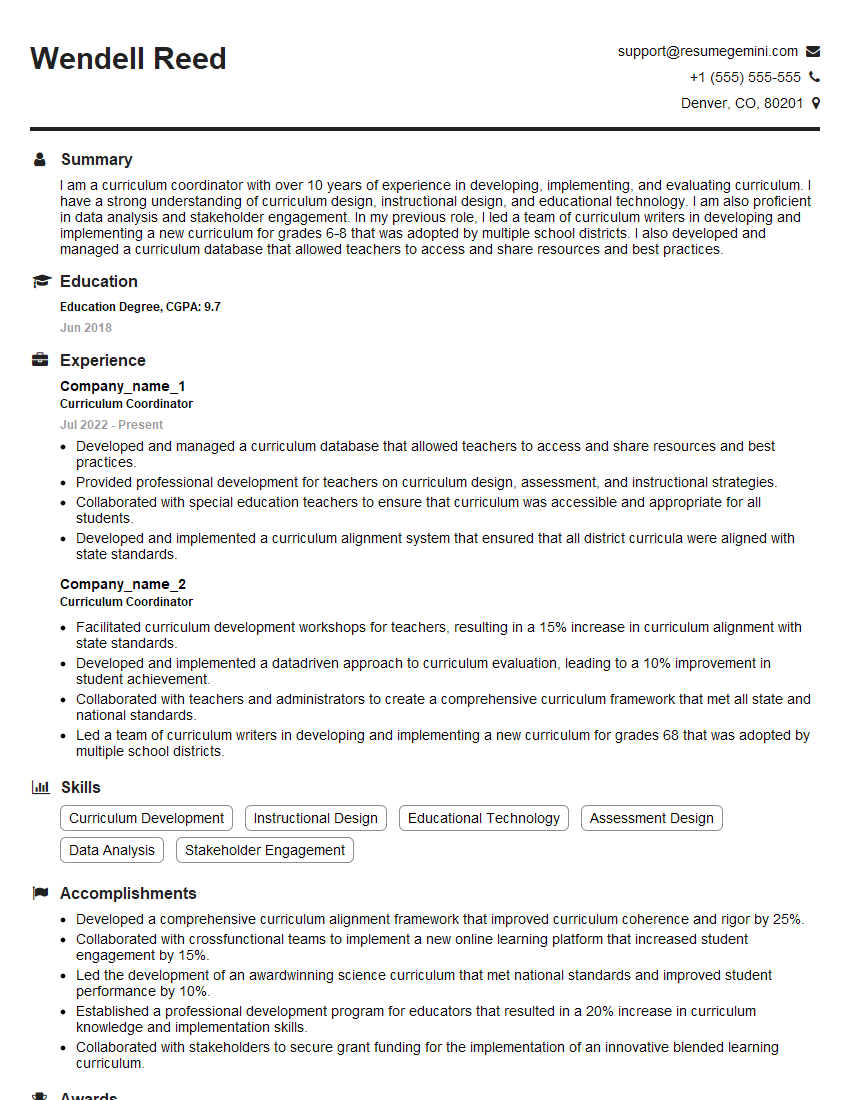Cracking a skill-specific interview, like one for Cooperative Learning and Peer Instruction, requires understanding the nuances of the role. In this blog, we present the questions you’re most likely to encounter, along with insights into how to answer them effectively. Let’s ensure you’re ready to make a strong impression.
Questions Asked in Cooperative Learning and Peer Instruction Interview
Q 1. Define cooperative learning and differentiate it from group work.
Cooperative learning and group work are often used interchangeably, but there’s a crucial difference. Group work simply involves students working together on a task. Cooperative learning, however, is a structured, purposeful approach to group work where students are actively engaged in a shared learning goal, working collaboratively and holding each other accountable for understanding the material. It’s not just about completing a task together; it’s about learning together. Think of it like this: group work is like throwing a bunch of ingredients in a pot; cooperative learning is a recipe that guides the mixing, cooking, and tasting to ensure a delicious outcome – shared understanding.
In cooperative learning, the teacher designs specific activities and roles, assigns responsibility, and provides clear learning objectives. This intentional structure fosters a positive interdependence among students, promoting peer interaction, support, and mutual learning. Group work, on the other hand, can lack these crucial elements, potentially resulting in some students dominating or others disengaging.
Q 2. Explain the key elements of effective peer instruction.
Effective peer instruction hinges on a few key elements: Concept introduction (instructor presents a concept), individual thinking (students individually reflect on the concept and formulate their understanding), peer interaction (students discuss their answers in pairs or small groups, justifying their reasoning), class-wide discussion (instructor facilitates a whole-class discussion, addressing common misconceptions and reinforcing correct understanding), and follow-up activities (e.g., homework assignments, quizzes) to consolidate learning. The process is iterative; the instructor might revisit the concept using different examples or approaches based on student feedback during the peer interaction and class discussion phases. It’s a cyclical approach designed to continuously refine student understanding.
Imagine teaching the concept of photosynthesis. After a brief introduction, students individually answer a multiple-choice question. They then discuss their answers with a partner, explaining their reasoning. This peer discussion often resolves misunderstandings. Finally, the class discusses the correct answer, addressing any lingering confusion. This interactive process is far more effective than a simple lecture.
Q 3. Describe three different cooperative learning structures and their applications.
Here are three cooperative learning structures and their applications:
- Think-Pair-Share: Students individually reflect on a question or problem, discuss their ideas with a partner, and then share their conclusions with the larger group. Application: Ideal for quick checks for understanding, generating initial ideas, or summarizing key concepts. For example, after a lecture on cell biology, students could Think about a key concept, Pair with a partner to discuss it, and then Share their understanding with the class.
- Jigsaw: Students are divided into expert groups, each responsible for mastering a specific aspect of a topic. They then regroup into ‘jigsaw’ groups, where each student teaches their expert knowledge to their new group members. Application: Effective for covering large amounts of material, promoting deep understanding, and developing communication skills. For instance, in a history class studying the American Revolution, each expert group could focus on a different aspect (political, economic, social) before regrouping to share their expertise.
- Team-Based Learning (TBL): This involves individual readiness assurance tests (IRATs) to assess prior knowledge, team activities to apply and discuss concepts, and peer evaluation to assess individual and team contributions. Application: Well-suited for complex problems or case studies where students need to synthesize information and make decisions collaboratively. For instance, a business class could use TBL to analyze a business case, assigning different roles within the team to simulate a real-world business scenario.
Q 4. What are the benefits and challenges of implementing peer instruction in a large classroom?
Implementing peer instruction in large classrooms presents both benefits and challenges. The benefits include increased student engagement and active learning, improved understanding of concepts through peer interaction, and opportunities for formative assessment. However, the challenges include managing the logistics of peer interaction in a large setting (ensuring enough time for group discussion and potentially quieter students being heard), preventing some students from dominating the discussion, and providing timely feedback to all student groups. To overcome these challenges, instructors can use techniques like assigning roles within groups (e.g., presenter, summarizer, questioner), providing structured discussion prompts, and circulating among the groups to monitor participation and offer assistance. Technology, such as online discussion forums, can also facilitate peer interaction in large classes.
Q 5. How would you assess student learning in a cooperative learning environment?
Assessing student learning in a cooperative learning environment requires a multifaceted approach. Traditional methods like tests and quizzes can assess individual understanding, but they don’t fully capture the collaborative aspects of learning. Therefore, it’s essential to incorporate methods that measure both individual and group performance. This can involve:
- Individual assessments: Tests, quizzes, and assignments to measure individual knowledge acquisition.
- Group projects and presentations: To assess collaborative problem-solving skills and knowledge synthesis.
- Peer evaluations: To gauge individual contributions within the group and the quality of peer interaction.
- Observations: Teacher observation of group dynamics and individual participation during activities.
- Self and peer-reflection activities: To encourage students to reflect on their learning processes and identify areas for improvement.
Combining these methods provides a comprehensive picture of student learning in a cooperative setting.
Q 6. How do you address unequal participation among students in cooperative learning groups?
Unequal participation is a common challenge in cooperative learning. To address this, proactive strategies are crucial. Before group activities begin, clearly define roles and responsibilities for each group member to encourage active involvement from all. Regularly rotate group members to prevent the formation of consistently dominant or passive groups. Use techniques like ‘think-pair-square’ or other structured discussions to give every student a chance to voice their opinions. Provide clear guidelines for respectful communication and active listening. During group activities, circulate among groups to observe dynamics and intervene when necessary, encouraging quieter students to contribute. Utilize peer evaluation methods to hold all members accountable for their participation.
Q 7. What strategies would you use to ensure accountability within peer learning groups?
Accountability within peer learning groups is essential for maximizing the effectiveness of cooperative learning. Here are some strategies to ensure it:
- Individual Accountability: Each student should be responsible for their contribution to the group’s overall success. This can be achieved through individual quizzes, assignments, or reflections related to the group task.
- Group grading with individual components: Part of the group grade can be based on the group’s performance, and another part based on individual contributions. This ensures that students understand they’re accountable for their actions even within a group.
- Peer evaluation: Students evaluate each other’s contributions, promoting self-reflection and providing feedback. It’s important to clearly define criteria for evaluation.
- Random selection of individual work: For presentations or problem-solving tasks, randomly selecting an individual within the group to present or explain the group’s work increases individual accountability.
- Group contracts: Having groups create a contract outlining expected behaviors, participation levels, and responsibilities helps establish norms and clarifies expectations.
By combining these strategies, you can create a supportive yet accountable learning environment where all students are actively engaged and responsible for their learning.
Q 8. Discuss the role of the instructor in facilitating cooperative learning activities.
The instructor’s role in facilitating cooperative learning is multifaceted, extending beyond simply assigning groups. It’s about creating a supportive environment where students learn from each other effectively. This involves careful planning, proactive guidance, and ongoing monitoring.
- Structured Activities: The instructor designs tasks that require collaboration and interdependence, ensuring each student contributes meaningfully. This might involve jigsaw activities where each group member is responsible for a different piece of information, or problem-solving scenarios demanding diverse skills.
- Clear Expectations: Setting clear roles, responsibilities, and assessment criteria for group work is crucial. Students need to understand how their individual contributions will impact the overall group success.
- Skill Development: The instructor proactively teaches collaborative skills such as active listening, conflict resolution, and effective communication. This might involve explicit instruction or modeling during group activities.
- Monitoring and Intervention: Regular monitoring of group dynamics allows the instructor to identify and address potential issues before they escalate. This might involve circulating amongst groups, observing interactions, and providing timely support or adjustments.
- Debriefing and Reflection: Post-activity discussions allow students to reflect on the process, their contributions, and what they learned. This helps solidify learning and improve future collaborative efforts.
For example, in a history class, instead of individual research papers, I might assign groups to investigate different aspects of a historical event, then present their findings collaboratively. This fosters deeper understanding and allows for peer learning.
Q 9. How would you adapt cooperative learning strategies for diverse learners?
Adapting cooperative learning for diverse learners requires a differentiated approach that caters to individual needs and learning styles. It’s about creating flexible structures that accommodate various learning preferences and abilities.
- Varied Grouping Strategies: Implementing heterogeneous grouping (mixing learners with different strengths) promotes peer tutoring and diverse perspectives, while homogeneous grouping (grouping learners with similar skills) can provide tailored support to struggling learners.
- Accessible Materials: Providing materials in various formats – text, audio, video, visual aids – ensures inclusivity. Consider using assistive technology and alternative assessment methods.
- Differentiated Tasks: Assigning tasks that are challenging yet achievable for all learners is critical. This might involve providing different levels of scaffolding or modifying task complexity based on individual needs.
- Choice and Autonomy: Offering students choices in activities, roles, and presentation formats enhances engagement and allows them to utilize their strengths. This can boost self-esteem and motivation among diverse learners.
- Clear Communication and Support: Establish clear communication channels and provide ample support to learners who might need more guidance or assistance. This often involves utilizing learning assistants, mentors, or peer tutors.
For example, in a science lab, I might offer different levels of guidance for lab reports, with detailed rubrics and exemplars for students needing extra support and more open-ended prompts for advanced learners.
Q 10. How do you handle conflict within cooperative learning groups?
Conflict is inevitable in group work, but it can be a valuable learning opportunity if handled effectively. Proactive strategies are key to minimizing conflict and resolving it constructively.
- Establish Norms: Begin with a discussion about group norms and expectations, emphasizing respect, active listening, and constructive feedback. Model positive interactions.
- Mediation and Facilitation: If conflict arises, facilitate a structured discussion where students can express their perspectives and work towards a resolution. Act as a neutral mediator, guiding them towards finding common ground.
- Individual Reflection: Encourage individual reflection on personal contributions to group dynamics. This might involve journaling or self-assessment activities to understand how individual actions might contribute to conflict.
- Conflict Resolution Strategies: Teach students specific conflict resolution strategies, such as compromise, negotiation, and empathy. Role-playing scenarios can help them practice these skills.
- Re-grouping: In extreme cases, regrouping might be necessary if a particular dynamic is consistently unproductive. This should be done sensitively and with a clear rationale.
For instance, if a group is experiencing disagreements, I might facilitate a conversation using a structured approach like the ‘fishbone diagram’ to identify root causes of the conflict and brainstorm solutions together. This promotes understanding and collaboration.
Q 11. Explain the concept of ‘positive interdependence’ in cooperative learning.
Positive interdependence is a cornerstone of cooperative learning, meaning group members must rely on each other to achieve a common goal. It’s not just working together; it’s understanding that individual success is intertwined with the group’s success.
This is fostered by:
- Shared Goals: Groups work towards a common objective, understanding that everyone’s contribution is necessary for success.
- Resource Interdependence: Groups may share resources or materials, requiring collaboration and coordination to utilize them effectively.
- Role Interdependence: Assigning specific roles within the group ensures each member has a vital function, creating mutual reliance.
- Outcome Interdependence: Group success is shared and equally rewarded, reinforcing the sense of interdependence. This could be a group grade, a shared presentation score, or collective recognition.
Think of a rowing team: each rower plays a crucial role. If one rower slacks off, the entire team suffers. This is a perfect example of positive interdependence.
Q 12. Describe your experience using technology to support cooperative learning.
Technology significantly enhances cooperative learning. I’ve used various tools to facilitate collaboration and communication, both synchronously and asynchronously.
- Online Collaboration Platforms (e.g., Google Docs, Microsoft Teams): These platforms allow students to work together on documents, spreadsheets, and presentations in real-time, regardless of location. This fosters collaboration even outside the classroom.
- Interactive Whiteboards (e.g., Miro, Jamboard): Interactive whiteboards facilitate brainstorming, mind-mapping, and collaborative problem-solving in a visual and engaging manner.
- Video Conferencing (e.g., Zoom, Google Meet): Video conferencing enables synchronous group discussions, project planning, and peer feedback sessions, mimicking in-person collaboration.
- Learning Management Systems (e.g., Canvas, Blackboard): LMS platforms can be used to assign group projects, facilitate communication, and manage submission of collaborative work.
- Educational Simulations and Games: Online simulations and games can promote collaborative problem-solving and engagement.
For example, in a marketing class, students used Google Slides to collaboratively create a marketing campaign presentation, allowing each student to contribute different aspects of the project concurrently.
Q 13. What are some effective techniques for providing feedback in a peer learning setting?
Effective peer feedback is crucial for learning in peer instruction. It needs to be specific, constructive, and actionable.
- Structured Feedback Forms: Providing students with structured forms guides them in providing relevant feedback. This might include rating scales, checklists, or open-ended prompts focused on specific criteria.
- Peer Feedback Rubrics: Rubrics clarify expectations and help students assess their peers’ work objectively and fairly. They provide concrete guidelines for evaluation.
- Training and Modeling: Students should be trained on how to give effective feedback. Modeling positive feedback strategies and providing examples helps them understand what constitutes helpful criticism.
- Self-Reflection and Metacognition: Encourage students to reflect on their own learning and to consider how feedback can improve their performance. This fosters self-regulation.
- Response and Revision Opportunities: Students should have opportunities to respond to feedback and revise their work based on the suggestions they receive. This makes feedback an active component of the learning process.
For instance, after a debate, students use a peer feedback form to assess their partner’s argumentation skills, focusing on clarity, evidence, and counter-arguments. This approach yields specific and helpful feedback.
Q 14. How do you monitor student understanding during peer instruction activities?
Monitoring student understanding during peer instruction requires a blend of formative assessment techniques. It’s about gauging both individual and group learning.
- Concept Tests and Quizzes: Before and after peer instruction activities, administer short quizzes or concept tests to gauge understanding. Compare pre- and post-test scores to measure learning gains.
- Think-Pair-Share Activities: Incorporate brief ‘think-pair-share’ activities to allow students to articulate their understanding and receive immediate feedback from peers.
- Group Work Observation: Circulate amongst groups, observing students’ interactions and their ability to explain concepts to one another. This provides insights into group dynamics and individual comprehension.
- Peer Feedback Mechanisms: Use peer feedback forms to allow students to assess their peers’ understanding and identify areas where further clarification is needed.
- Class Discussions and Questioning: Encourage class discussions and pose thoughtful questions to assess overall comprehension. Pay attention to student responses and the quality of their explanations.
For example, after a lecture on photosynthesis, I might use a quick multiple-choice question to check understanding before initiating a peer instruction discussion. Following the discussion, I would use a similar question to assess the impact of the peer interaction on understanding. Analyzing both sets of answers would demonstrate improvement or areas needing attention.
Q 15. How would you design a peer instruction activity for a specific learning objective?
Designing a peer instruction activity starts with a clearly defined learning objective. Let’s say the objective is for students to understand the difference between osmosis and diffusion. First, I’d present a concise explanation of both concepts, perhaps with a simple diagram. Then, I’d pose a multiple-choice question that directly assesses understanding of the key distinction – for example, a question describing a scenario and asking whether it’s osmosis or diffusion. Students individually answer, then discuss their answers with a partner. After this, I’d reveal the correct answer and facilitate a whole-class discussion to address any lingering misconceptions. This process, involving individual reflection, peer interaction, and instructor-led clarification, strengthens comprehension and encourages active learning. The key is to design questions that directly target the learning objective and encourage critical thinking, not just rote memorization.
For example, a question might be: “A cell is placed in a hypotonic solution. Which process is primarily responsible for water movement into the cell? a) Diffusion b) Osmosis c) Active Transport d) Facilitated Diffusion.” The subsequent discussion allows students to explain their reasoning to each other, strengthening their understanding and identifying misconceptions.
Career Expert Tips:
- Ace those interviews! Prepare effectively by reviewing the Top 50 Most Common Interview Questions on ResumeGemini.
- Navigate your job search with confidence! Explore a wide range of Career Tips on ResumeGemini. Learn about common challenges and recommendations to overcome them.
- Craft the perfect resume! Master the Art of Resume Writing with ResumeGemini’s guide. Showcase your unique qualifications and achievements effectively.
- Don’t miss out on holiday savings! Build your dream resume with ResumeGemini’s ATS optimized templates.
Q 16. What are some common misconceptions about cooperative learning?
A common misconception about cooperative learning is that it’s simply group work. It’s not enough to just put students in groups; true cooperative learning requires specific structures to ensure positive interdependence, individual accountability, and the development of interpersonal skills. Another misconception is that it’s always less efficient than direct instruction. While it requires more initial setup, the deeper understanding and improved retention often outweigh the time investment. Finally, some believe cooperative learning only benefits higher-achieving students. In reality, it’s highly beneficial for all students, as higher-achieving students develop their communication and teaching skills while lower-achieving students benefit from peer support and explanation. Effective cooperative learning structures are key to counteracting these misconceptions.
Q 17. How would you evaluate the effectiveness of a cooperative learning activity?
Evaluating the effectiveness of a cooperative learning activity is multifaceted. I’d employ a combination of methods. First, I’d use formative assessments like quizzes or short answer questions both before and after the activity to gauge changes in understanding. This provides quantitative data on learning gains. Second, I’d observe group dynamics during the activity, noting levels of participation and collaboration. This qualitative data reveals how well students are interacting and supporting each other. Finally, I’d gather student feedback through surveys or short reflections to understand their perspectives on the activity’s effectiveness and identify areas for improvement. A comprehensive evaluation considers both student learning outcomes and the quality of the collaborative process itself.
Q 18. Describe a time you successfully implemented cooperative learning in a challenging situation.
I once implemented cooperative learning in a challenging situation involving a large class of 60 students with vastly different levels of prior knowledge in a complex physics topic. Simply lecturing wasn’t effective. I divided the class into smaller groups with a mix of ability levels, assigning each group a specific aspect of the topic to explore through research and collaborative problem-solving. I provided clear guidelines for group roles (leader, researcher, presenter, etc.), and regular check-ins ensured each student was actively participating. Using a jigsaw technique, each group became experts in their area and then taught the rest of the class, promoting peer learning. The result was a significantly improved class understanding of the concepts, even in students who initially struggled, and a stronger sense of community within the class. This showcased the power of cooperative learning in overcoming challenges related to class size, diverse abilities, and complex material.
Q 19. What are some examples of effective peer assessment strategies?
Effective peer assessment strategies go beyond simple grading. One effective method is using rubrics, providing students with clear criteria for evaluating each other’s work. This ensures consistency and fairness. Another is using self and peer feedback forms, where students reflect on their own work and provide constructive criticism to their peers. This encourages metacognition and improves self-awareness. Finally, incorporating peer review sessions, where students present their work to a small group for feedback, fosters active listening and communication skills while improving the quality of the work itself. The key is to provide structured feedback mechanisms and clear guidelines to ensure the process is productive and supportive.
Q 20. How can you ensure that peer instruction is aligned with learning outcomes?
Aligning peer instruction with learning outcomes requires careful planning. First, the learning objectives must be explicitly stated and understood by both the instructor and students. The questions used in peer instruction should directly assess the attainment of these objectives. For example, if the objective is to solve quadratic equations, the questions should require students to demonstrate this skill. The discussion prompts following the questions should guide students towards a deeper understanding of the underlying concepts. The post-discussion review of the correct answers and explanation ensures that any misconceptions are addressed, directly tying back to the learning outcomes. This holistic approach ensures the peer instruction activity effectively contributes to achieving the stated learning goals.
Q 21. What are the challenges of implementing peer instruction in online learning environments?
Implementing peer instruction in online learning environments presents unique challenges. One major challenge is ensuring active participation and meaningful interaction among students. Digital tools like online forums or collaborative document editing software can help, but maintaining engagement requires thoughtful design and facilitation. Another challenge is monitoring group dynamics and ensuring equitable participation. Online anonymity can hinder accountability, and instructors need strategies to observe and address issues. Finally, assessing the quality of online discussions and peer interactions requires innovative approaches beyond simply reviewing written text. Careful consideration of these aspects is crucial for successfully adapting peer instruction to online settings.
Q 22. How do you address the issue of students who are reluctant to participate in group activities?
Reluctance to participate in group activities stems from various factors, including shyness, fear of judgment, lack of confidence, or previous negative experiences. Addressing this requires a multifaceted approach focusing on building trust, fostering a supportive environment, and providing appropriate scaffolding.
Building Trust and Rapport: Begin with icebreaker activities that encourage low-stakes interaction and allow students to get to know each other. Establishing clear norms of respect and collaboration is crucial. For example, I might start with a simple ‘Two Truths and a Lie’ game to help students connect on a personal level.
Differentiated Instruction and Choice: Offer various roles within group activities, catering to diverse learning styles and preferences. Some students might prefer research roles, others presentation, and others might excel as facilitators. Giving students choices empowers them and increases their comfort level.
Gradual Progression: Start with smaller, less intimidating group tasks before moving to larger, more complex ones. Success in smaller groups builds confidence and prepares students for more challenging collaborative endeavors. Think of it like learning to swim: you start with kicking in shallow water before tackling the deep end.
Providing Support and Feedback: Regularly check in with students, providing constructive feedback and guidance. Addressing concerns and anxieties directly can help alleviate their reluctance. Offering opportunities for individual reflection and contribution before full group participation is also beneficial.
Positive Reinforcement: Publicly acknowledge and praise both individual and group efforts, focusing on the process and improvement rather than just the final outcome. This helps create a positive feedback loop that encourages participation.
Q 23. What are the ethical considerations involved in peer assessment?
Ethical considerations in peer assessment are paramount. Fairness, transparency, and protecting student privacy are key concerns. We must ensure that the assessment process is equitable and doesn’t disadvantage any student.
Clear Rubrics and Criteria: Providing students with detailed rubrics and assessment criteria ensures everyone understands the expectations. This minimizes bias and promotes consistent evaluation. Students should know exactly what constitutes excellent, good, fair, and poor work.
Anonymity and Confidentiality: Protecting student identity and keeping their feedback confidential is crucial. Students should feel safe offering honest feedback without fear of repercussions. This might involve using coded names or online platforms that maintain anonymity.
Training and Guidance: Students should receive training on providing constructive and respectful feedback. This helps them understand how to be both critical and supportive. Role-playing scenarios can be valuable for practice.
Addressing Bias: Teachers must be vigilant in identifying and addressing potential biases within peer assessment. Providing opportunities for students to reflect on their own biases and practice objective evaluation is essential. This might involve a self-reflection activity focused on fair assessment.
Student Voice and Agency: Involving students in the design and implementation of the peer assessment process empowers them and fosters a sense of ownership. This can involve discussing criteria, providing feedback on the rubric, or designing assessment tasks collaboratively.
Q 24. Describe the differences between structured and unstructured cooperative learning activities.
Structured cooperative learning activities involve clearly defined roles, tasks, and procedures, whereas unstructured activities offer more flexibility and student autonomy. Both have their place, depending on the learning objective and student readiness.
Structured Activities: These activities often involve pre-assigned roles (e.g., reader, recorder, reporter, researcher) and specific steps to follow. Think of Jigsaw activities, where students become experts on a specific part of a topic and then teach their peers. This provides clear expectations and guidance, particularly beneficial for younger learners or those new to collaborative learning.
Unstructured Activities: These activities provide students with more freedom in how they approach the task. For example, a brainstorming session or a project where students design their own research plan allows for creativity and independent problem-solving. However, clear learning objectives and guidelines are still necessary to ensure the activity stays on track and fosters collaboration, even in these unstructured situations.
The key difference lies in the level of teacher guidance and control. Structured activities provide more support and scaffolding, while unstructured activities promote greater student independence and self-directed learning.
Q 25. How do you select appropriate cooperative learning strategies for different subject matter?
Selecting appropriate cooperative learning strategies depends on the subject matter’s complexity, the learning objectives, and the students’ prior knowledge and skills. For example, a complex scientific concept might necessitate a structured approach like Think-Pair-Share, allowing for incremental understanding. A more creative task, like writing a story, could be tackled with a less structured approach emphasizing collaborative brainstorming.
Concept Attainment: For introducing new concepts, Think-Pair-Share or Jigsaw are effective. Think-Pair-Share involves students individually reflecting on a concept, discussing it with a partner, and then sharing with the larger group. Jigsaw allows for specialized learning and peer teaching.
Problem-Solving: For problem-solving, collaborative problem-solving strategies, such as group investigation or project-based learning, are excellent choices. These strategies allow students to work together to analyze problems, propose solutions, and evaluate outcomes.
Application and Practice: For applying knowledge and practicing skills, activities like role-playing or simulations can foster active learning and collaboration. These activities allow students to apply their understanding in a practical context.
The choice of strategy should align with the learning goals. It’s crucial to consider the cognitive load and the level of support needed by students. A trial-and-error approach, adapting strategies based on student responses, is often necessary.
Q 26. How do you foster a positive learning environment conducive to cooperative learning?
Fostering a positive learning environment for cooperative learning involves creating a culture of respect, trust, and collaboration. This requires proactive effort from the teacher and consistent reinforcement of positive behaviors.
Establish Clear Expectations and Norms: Communicate expectations for group work clearly, including rules for respectful interaction, active listening, and equitable contribution. Collaboratively develop class norms with student input to promote ownership and commitment.
Promote Positive Interdependence: Structure activities so students need each other to succeed. This ensures everyone feels responsible for the group’s outcome and motivates active participation. For instance, assign roles where each student has a unique contribution that benefits the group.
Build Social Skills: Integrate activities that explicitly teach and practice social skills like communication, conflict resolution, and empathy. This is especially valuable if students lack experience working collaboratively.
Provide Opportunities for Reflection: Regularly encourage students to reflect on their group work experiences, both positive and negative. This helps identify areas for improvement and fosters metacognitive awareness. Reflection journals or group discussions can facilitate this process.
Celebrate Successes: Publicly acknowledge and celebrate both individual and group accomplishments to reinforce positive behaviors and boost morale. Simple acts of recognition can go a long way in creating a supportive learning environment.
Q 27. Discuss the importance of providing clear instructions and expectations for cooperative learning activities.
Clear instructions and expectations are the cornerstone of successful cooperative learning. Ambiguity can lead to confusion, frustration, and ultimately, ineffective collaboration. Providing detailed guidance helps students understand their roles, the task’s requirements, and the assessment criteria.
Detailed Written Instructions: Provide students with written instructions that outline the task’s purpose, steps, roles, and timeline. Using visuals, diagrams, or examples can enhance understanding.
Verbal Explanations and Modeling: Supplement written instructions with clear verbal explanations. Demonstrate the process by modeling the activity or using a think-aloud strategy. This clarifies any ambiguities and provides a concrete example.
Check for Understanding: Before students begin the activity, check for understanding by asking questions or having them paraphrase the instructions. Addressing any confusion early on prevents problems later.
Scaffolding and Support: Provide scaffolding or support as needed, particularly for challenging tasks. This may involve breaking down tasks into smaller, manageable steps, offering templates or checklists, or providing access to additional resources.
Clear Assessment Criteria: Ensure students understand how their work will be assessed. Use rubrics or checklists to clarify expectations and provide a framework for evaluating both individual and group contributions.
Q 28. Explain how you would use formative assessment to inform your cooperative learning instruction.
Formative assessment plays a vital role in informing and adjusting cooperative learning instruction. It provides valuable feedback to both students and the teacher, allowing for timely interventions and improvements.
Observation and Monitoring: Regularly observe students during group work, noting their interactions, problem-solving strategies, and communication effectiveness. This provides insights into group dynamics and individual contributions.
Informal Checks for Understanding: Use short quizzes, quick writes, or informal questioning to gauge students’ understanding of concepts during group work. This helps identify areas where students need additional support or clarification.
Peer Feedback and Self-Assessment: Incorporate peer and self-assessment strategies into cooperative learning activities. This provides students with valuable feedback and promotes self-reflection. Peer assessment forms or self-reflection prompts can be useful tools.
Group Presentations and Discussions: Have groups present their work or engage in discussions to share their findings and receive feedback from peers and the teacher. This allows for collective learning and identification of areas for improvement.
Adjusting Instruction Based on Feedback: Use the data collected from formative assessment to adjust your instruction. This may involve providing additional support to struggling groups, modifying activities to better address learning needs, or reinforcing successful strategies.
Key Topics to Learn for Cooperative Learning and Peer Instruction Interview
- Cooperative Learning Structures: Understand various cooperative learning structures (e.g., Think-Pair-Share, Jigsaw, STAD) and their effectiveness in different learning contexts. Consider the advantages and disadvantages of each.
- Peer Instruction Principles: Grasp the core principles of peer instruction, including the role of student interaction, concept testing, and immediate feedback in enhancing learning outcomes. Be prepared to discuss the research supporting its efficacy.
- Designing Effective Activities: Explore the practical application of these strategies. How do you design engaging and effective cooperative learning and peer instruction activities? Consider factors like group size, task complexity, and assessment methods.
- Classroom Management Techniques: Discuss strategies for managing groups effectively, fostering positive peer interactions, and addressing potential challenges such as student conflict or unequal participation.
- Assessment and Evaluation: Understand how to effectively assess student learning within a cooperative learning framework. This includes considering both individual and group contributions.
- Theoretical Frameworks: Familiarize yourself with relevant learning theories (e.g., social constructivism, sociocultural theory) that underpin cooperative learning and peer instruction.
- Technology Integration: Explore how technology can be integrated into cooperative learning and peer instruction activities to enhance engagement and collaboration.
- Adapting to Diverse Learners: Discuss strategies for adapting cooperative learning and peer instruction to meet the needs of diverse learners with varying learning styles and abilities.
- Analyzing Learning Outcomes: Be prepared to discuss how you would analyze data to determine the effectiveness of your cooperative learning and peer instruction strategies.
Next Steps
Mastering Cooperative Learning and Peer Instruction demonstrates a valuable skill set highly sought after in education and related fields. It showcases your ability to foster collaborative learning environments and positively impact student outcomes. This expertise will significantly boost your career prospects. To maximize your job search success, create an ATS-friendly resume that effectively highlights your skills and experience. ResumeGemini is a trusted resource that can help you build a compelling and impactful resume. Examples of resumes tailored to Cooperative Learning and Peer Instruction are provided to further assist you in this process.
Explore more articles
Users Rating of Our Blogs
Share Your Experience
We value your feedback! Please rate our content and share your thoughts (optional).
What Readers Say About Our Blog
These apartments are so amazing, posting them online would break the algorithm.
https://bit.ly/Lovely2BedsApartmentHudsonYards
Reach out at [email protected] and let’s get started!
Take a look at this stunning 2-bedroom apartment perfectly situated NYC’s coveted Hudson Yards!
https://bit.ly/Lovely2BedsApartmentHudsonYards
Live Rent Free!
https://bit.ly/LiveRentFREE
Interesting Article, I liked the depth of knowledge you’ve shared.
Helpful, thanks for sharing.
Hi, I represent a social media marketing agency and liked your blog
Hi, I represent an SEO company that specialises in getting you AI citations and higher rankings on Google. I’d like to offer you a 100% free SEO audit for your website. Would you be interested?

